|
May 13, 2004
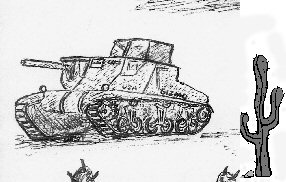
Where Heroes Trained
by Roger M. Baty Ph.D.
Assembly Room, A. K. Smiley Public Library
About the Author
Two years ago, Roger Baty retired from the University of Redlands after serving there for thirty-three years in various capacities -- founding fellow of Johnston College, Director of the Armacost Library, and Professor of Anthropology. For twenty-two of those years he participated in the Fortnightly Club and received honorary membership status in May, 1993.
His formal higher education began at the University of Montana where he received a degree in Economics. From there he studied at Merton College, Oxford, receiving a degree in Philosophy, Politics and Economics. He earned a doctorate in International Development Education at Stanford University.
Roger is married to Phebe and they have three children who grew up in Redlands. Son Jonathan and his wife Michelle now live in Redlands; daughter Iliniza and her husband Won Kim live in Santa Monica; daughter Marguerite is studying at Johns Hopkins in Baltimore, Maryland.
Throughout his time in Redlands, Roger has taken a keen interest in the American Southwest; particularly the desert regions now overseen by the Bureau of Land Management. His interests have led him to write a book about some of the activities in the desert during World War II. His paper "Where Heroes Trained," is also the title of his forthcoming book.
Summary
"Where Heroes Trained" is the title of a book which Eddie Maddox Jr and I are compiling. The book combines oral history interviews with research in the National Archives. It treats the story of the 736th Tank Battalion from its activation in February 1943 until departure for the European Theater of Operations in April 1944.
Training began in Camp Rucker, Alabama. Secret advanced training took place at Fort Knox, Kentucky, and secret battle training was in Butler Valley, part of the Desert Training Center and California-Arizona Maneuver Area (CAMA). Much of what we are sharing was secret at the time. After basic training at Camp Rucker, the men were forbidden to talk about what they were doing. Some found it difficult to talk with us about what went on, even though sixty years had passed.
The book contains oral history interviews from more than twenty veterans of the battalion. Most were born in 1923. One was born in 1927 and one in 1918. A question I am often asked is "How did you find the guys to interview?" The answer to that question is the topic of this paper.
Keywords
736 TANK BATTALION ;WORLD WAR 2 ;DESERT TRAINING CENTER ;CALIFORNIA - ARIZONA MANEUVER AREA ;CAMA ;CAMP BOUSE ;TRAINING ;CAMP RUCKER ;FORT KNOX ;150TH STATION HOSPITAL ;SECRET WEAPON ;T-10 SHOP TRACTOR ;PROJECT CASSOCK ;Heroes ;Gizmo Tank ;Canal Defense Light ;Operation Leaflet ;Butler Valley ;Armor ;M-3 Lee tank ;ORAL HISTORY;
Where Heroes Trained
Mr. President of the Fortnightly Club, distinguished members, and honored guests, let me begin by thanking you for approving the title of my paper for today's session, the 1700th meeting since the Club began in 1895. "Where Heroes Trained" is the title of a book which Eddie Maddox Jr and I are compiling. The book combines oral history interviews with research in the National Archives. It treats the story of the 736th Tank Battalion from its activation in February 1943 until departure for the European Theater of Operations in April 1944.
Training began in Camp Rucker, Alabama. Secret advanced training took place at Fort Knox, Kentucky, and secret battle training was in Butler Valley, part of the Desert Training Center and California-Arizona Maneuver Area (CAMA). Much of what we are sharing was secret at the time. After basic training at Camp Rucker, the men were forbidden to talk about what they were doing. Some found it difficult to talk with us about what went on, even though sixty years had passed.
The book contains oral history interviews from more than twenty veterans of the battalion. Most were born in 1923. One was born in 1927 and one in 1918. A question I am often asked is "How did you find the guys to interview?" The answer to that question is the topic of my paper today.
It was January first, 2002. I was recovering from radiation treatment for prostate cancer and about to return to teaching at the University of Redlands. As part of my therapy and recovery effort, Don Hunt and I were seeking to add the elusive Camp Bouse to our list of visited sites which comprised General Patton's Desert Training Center. Our guide for this adventure was a publication by John S. Lynch, retired Air Force Lieutenant Colonel, and two of his colleagues. In their book, Patton's Desert Training Center, they describe Camp Bouse as "the mystery post of the California-Arizona Maneuver Area."
Along the east side of the highway passing through the town of Bouse, Arizona, we noticed a series of monuments and a cement ruin bearing a painting of a tank. "What on earth is that?" I asked myself. The tank didn't look like anything I was familiar with and here I was, an ex-Armor officer!
A hand-drawn map we found in the visitor sign-in register indicated the camp itself was about thirty miles away; too far for us to explore and complete the other camp visits we planned for that day. Resolving to return, we headed back toward home, punching our tickets for Desert Training Center camps Ibis, Goffs, and Essex on the way.
The eighth of February found us back in Bouse with time that Friday afternoon to look around and become better acquainted, while anticipating the community celebration of remembrance on Saturday. This celebration has taken place in Bouse each year since 1996. The town honors veterans of units that trained at Camp Bouse. The morning program showed us the heart of this American small town as the community embraced the stalwart veterans who were there and the spirits of those absent.
One unexpected pleasure was to meet our guidebook's author, Lt. Col. John S. Lynch. Don introduced me and said, "This is Dr. Baty. He's from the University of Redlands and he's writing a book."
"Yeah, right," I thought to myself. We're meeting the world's expert on the Desert Training Center and Don tells him I'm writing a book. Where did he get that, anyway? Yes, we had talked about a book but it was more about a book Don is working on, dealing with WW2 landing strips and airfields in the desert. Anyway, we continued to enjoy ourselves at the celebration.
After the ceremony, John Bennett, on behalf of the Bouse Chamber of Commerce, invited everyone to the Community Hall for lunch. Don and I ambled over there and partook of the delicious sloppy joes.
At one end of the hall, "Bud" Wall had a VCR going with World War 2 training videos. I watched one showing how to drive a tank. The tank commander indicated which direction to go by tapping the driver on the shoulder with his foot! After the video I noticed one of the veterans whom I'd seen at the celebration. He had been watching the same video.
"Howdy," I said. "Did you have anything to do with those tanks?"
"Oh, I got close to some of them," was the reply.
Our conversation continued and I learned that "Pete" Henson had served with the 736th Tank Battalion, one of six tank battalions that trained out at Camp Bouse. He had been a half-track driver in Headquarters Company. Now he lived in Wenden, Arizona, and drove over to the celebration. After we chewed the fat for a time, he offered to take me out to camp if I cared to visit.
True to his word, the next time I visited the area, in June, he personally guided me over the ground of the camp. We were tromping around the old camp, ignoring the heat and blazing sun, when Pete said, "You know, I don’t feel so good. I'm diabetic and forgot to bring my medicine."
I thought "Holy Smoke!" We're out here twelve miles from Wenden, thirty miles from Bouse, and I might have a real emergency on my hands. Just then, before panic set in, I remembered that my wife, Phebe, had prepared some trail mix for me, including raisins and dried cranberries. Pete eagerly accepted and the trail mix did the trick. We continued our survey of the site but decided not to head cross-country to find "8-Ball's" grave.
We got back to Wenden, safe and sound. I returned the following day from my motel in Salome. I began my first real oral history interview. Pete got to talking about his library and I thought, "Wow -- oral history with references -- it doesn't get better than this!" There was only one problem. His library had been destroyed by a flash flood a few years earlier. He had a few things in boxes he had rescued. He even took me to the place where his home had been. My heart sank. As a retired archaeologist, I had in the back of my mind a plan to excavate the ruin and find the library. But when I saw the mudflow that covered his dwelling my enthusiasm for digging vanished. I settled for an oral history interview.
Back at his new home (on higher ground) Pete explained what the tank battalions had been doing in the desert. They were training on a secret weapon, which the British were developing. The British replaced the turret of a "Matilda" infantry tank with one containing an armored searchlight, which they dubbed the "Canal Defense Light." The cover for the C.D.L. was that its use would be protecting the Suez Canal. The Americans kept the CDL terminology but mounted it on an M3A1 medium tank. The official term for this ungainly creature was the "leaflet." When American Locomotive began retrofitting the M3A1 to the CDL configuration, they referred to it as the T10 Shop Tractor. When the soldiers began training with the tank, it became the "Gizmo."
The tactical purpose of the weapon was to facilitate night fighting. Capable of illuminating the battlefield with 13 million candlepower of light, the enemy would be dazzled like deer caught in the headlights of advancing cars. They would be surprised and disoriented. The momentary confusion would enable our infantry and fighter tanks to close on their positions. Our own advancing troops would have no difficulty seeing the battlefield since it would be bathed in light out to one thousand yards in front of them. With this advantage, our troops would gain the upper hand and win the decisive battle.
Our interview lasted a couple of hours. At home I transcribed the tape and sent the transcript back to Pete for his editing and additions. He suggested changes and I returned a revised transcript. This process took several weeks and is essentially the same method I used in all the interviews.
Pete suggested a couple of others in California I might talk to. Art Alexander and Ramon Renteria both resided in southern California. (Social scientists refer to this as a "snowball" technique where one interview leads to several others and those lead to still more). Pete told me, "We get together for a reunion once a year and stay pretty close with Christmas cards and such."
The reunion idea intrigued me. Later in the summer, Art Alexander put me in touch with the reunion organizer and saw that I got an invitation. It would be in September and since I was no longer teaching, I could make the trip to Warner Robins, Georgia. The only catch was I would have to "sing for my supper" and tell the group what my purpose was in interviewing them.
When I left Warner Robins after three days of becoming acquainted, I drafted a thank-you to Jack Gay, editor of the Gizmo Gazette, which I quote from here:
Jack, thank you for inviting me to submit my after action report for the reunion. First off, I want to express appreciation to Ralph Wenrick for hosting the conference, to Vernon Tweit for inviting me, and to Art Alexander for encouraging me and suggesting that I could get an invitation if I called Vernon. Thanks to Eddie Maddox Jr and his father who put together a record of the actions and accomplishments of the 736th. Their publication stands as a testimony to you stalwart warriors. And I want to thank Pete Henson, champion of the 736th, for sharing from his memories and files and for personally guiding me over the ground at Camp Bouse earlier in the summer.
When I was "singing for my supper" you heard some of what I am trying to do. My plan is eventually to write the story of the two years during which over one million men were trained in the desert at more than twelve divisional camps. That story had been going on almost a year and a half by the time the 736th arrived. In terms of my methodology, following an oral history approach, one interview leads to another. During this reunion I found that there were times, sometimes in crowded rooms, sometimes off in the garden, when I was able to sit down and talk at length on a one-on-one basis and record portions of the conversation. So far I have transcribed the conversations I had with John Mellon, Joe Perrotti, Chet Clapper and Grady Gaston. I've sent them the transcripts along with a lengthy questionnaire that will form the basis of follow-up phone interviews.
Some of you have offered to share pictures. Jack Wireman kindly sent me some, which I scanned and returned to him. I have no desire to keep any original photos or memorabilia. In addition to the interviews, I have twenty-four signed forms, which I call my roster, signed by people who are willing for me to contact them and interview them over the phone….
Some of you asked about my military "credentials." I have spent a total of fourteen years in the US Army Reserves or California National Guard. In 1962 I was called back from England and in the fall of that year went to basic training at Fort Ord, or "Pneumonia Gulf" as we called it. You recall we had the Cuban missile crisis that fall. Much of our training took on a degree of heightened purpose since we thought we would be shipped to Cuba!
In May of 1964, my Army Reserve unit, a medical company of the 191st Infantry Brigade, participated in "Operation Desert Strike." This was my first exposure to the desert of California where, twenty years before, the Desert Training Center was established for Army training.
In 1978 I re-enlisted, this time in the California National Guard. My first duties were as a sergeant of the reconnaissance platoon in "C" Company of the 1/18 Cavalry Squadron belonging to the 40th Infantry Division (Mechanized). We trained at Fort Irwin toward the western side of the Mohave Desert region. Then, becoming an armor officer, with training at Fort Knox, and continuing in that capacity with many weekend and summer tours to Fort Irwin, my appreciation and understanding grew about moving troops in the desert, looking after their welfare, and the logistics of desert survival.
From that background, I am devoting the next years of my life as Research Professor Emeritus at the University of Redlands to this oral history project, including building a digital photo archive.
What I gained from the reunion is summed up by the many conversations and photographs of you all which I have, the memories of our excellent tours to Andersonville, and the Warner Robins Air Force Museum. But especially I shall never forget the admonition of our guest speaker, retired Brigadier General Seehorn. He quoted Brigadier General Robinson L. (Robbie) Reisner:
"To be born free is an accident.
To live free is a privilege.
To die free is a responsibility."
General Seehorn's accounts of his experiences as a prisoner of war in Vietnam, of the "terrible pain of freedom lost and the wonderful joy of freedom regained," will remain with me a long time. Thanks to you all for taking me in to your battalion family.
It took several months to digest the information from Warner Robins. I maintained contact with several members of the 736th and began researching the War in North Africa since that is where the units training in the desert in 1942 thought they were going. This seemed like the right direction when I encountered a soldier from the opposite side at a meeting of the Patton Army Air Field re-enactment group at Chiriaco Summit in October. George Magalowski said he had fought with Field Marshal Rommel. I was intrigued by the possibilities of including his account in my book.
By this time I had many leads and possible directions. While some doors opened, others closed. One of my potential interviewees flat out rejected my enquiries, saying "You are too late, and I am too tired."
Rick Atkinson's book, An Army at Dawn, provided a real boost to my enthusiasm for World War II investigations. But seeing the scale of what he is attempting started me thinking that perhaps instead of a book, I should be thinking about an article, and I began researching the "Gizmo." Using the world wide web brought me in touch with several people in England including David Fletcher, historian at the Tank Museum in Bovington, Dorset. He sent me some photos of the tank from his archive. I also found a well done article by Adrian James dealing with the CDL and its tactical deployment.
Eddie Maddox Jr, whom I met at the reunion, also became better known to me as we shared our enthusiasm for the battalion in phone conversations. He had lost his father in February 2002, and we shared a lot about losing close members of the family.
In early February of 2003, I returned to Bouse for the civic ceremony, this time as one of the guest speakers. This was a good time to renew friendships with the citizens of Bouse and to visit at length with Pete Henson. I also had the good fortune to meet Carsie Denning Sr. He had come all the way from Durham, North Carolina, to attend the Bouse ceremony. I knew from the couple of stories he told me that there were no doubt more stored away. He was one of the cadre training the soldiers on the use of the light at Fort Knox and was attached to the 736th for the voyage across the Atlantic.
In March, a conversation with a fellow military miniature enthusiast led to the name of a veteran who had trained on the searchlight tanks! His widow lived in San Francisco and I tried contacting her, but had no response. His name was Robert Grissilli and he was a member of the 736th Tank Battalion. While this information did not result in an interview, it was a story to tell. As I shared it with the 736ers I knew, I think it helped convince them that I was serious. It also served as another pointer to the 736th tank battalion and the possibilities of including them in my book about the Desert Training Center.
When September rolled around, Phebe and I followed our plan to attend the reunion of the battalion in Seattle and had a wonderful and relaxing drive north. We had a terrific time at the reunion and I think many of the guys were more willing to visit with me than they had been a year earlier. In my update speech at the banquet, I let them know that I was going to write a book entitled "Where Heroes Trained," that would incorporate many of their stories. Follow-up phone interviews really got going after that reunion.
In November I shared progress with Eddie Maddox and during the conversation he mentioned a readiness to help with the project. Now that was really important. Here was the guy who had compiled the only book about the 736th and he was offering to help. Eddie and his father had attended the reunion when it was held in Seattle in 1992. Eddie said the event was really special to his father since he had not seen his fellow soldiers in almost fifty years. The two of them began collecting information, thoughts and memories from the veterans. As time went by, what began as trying to save some of the stories and history of the battalion became a book. Eddie and his father published the "736th Special Tank Battalion" in 1997 and revised it a couple of years later.
Eddie and I had many lengthy phone conversations as we tried to figure out what our roles would be. It finally worked out that Eddie would continue interviewing the veterans following my interview schedule, and I would develop the narrative and chronology of what happened to the 736th Tank Battalion during its training in the U.S. That meant I had to make a trip to the National Archives.
In mid November I spent a week at the National Archives in College Park, Maryland, researching the Desert Training Center. On the way back to Redlands I stopped in Birmingham, Alabama and had a face-to-face conference with Eddie Maddox who had braved severe thunder storms and driven over from his home in Georgia for our meeting. At the airport we developed a plan for a second book on the 736th Tank Battalion.
We thought our audience would include 736th Tank Battalion veterans and their families, their counterparts in England, other World War II veterans, students of military history, college and university libraries and military museums.
If we worked our hardest, we thought we could complete ten to fifteen interviews by the end of March, 2004. By the end of April, the historical narrative would be complete. By the end of August we thought we could run off at least three copies to show people at the reunion, which this year will be in Branson, Missouri. Without exception, the members of the battalion were urging us to have something to show them before they passed on.
To gather more information about the 736th, I revisited the National Archives in mid January, assisted this time by Research Librarian Mitchell Yokelson who had the materials I needed all ready for me when I arrived. I got back to Redlands with enough information about the 736th , including many declassified documents, to build the chronology which provides the skeleton of our book. I liken the documents found to the warp threads on a loom with the interviews making up the weft threads that add the pattern to the weaving.
While I worked on the narrative, Eddie picked up the interviewing enabling us to include the stories of more than twenty veterans. As for our planned schedule, I am happy to report we have exceeded our hopes. This summer will see the publication of Where Heroes Trained and it will be available for the Branson reunion.
I have taken somewhat longer than I thought to answer the question, "Where did you find the guys to interview?" Now I am prepared to answer questions you might have about the book. I have some transcripts with me if you would like me to peruse some of the stories.
The photos added here come from my several trips to Bouse and the Camp augmented with a photo from the Tank Museum, Bovington, England, used with permission.
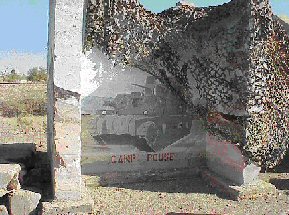
Painting of mystery tank by Diana Mae Evans, also a local historian and life-long resident of Bouse. Author's photo.
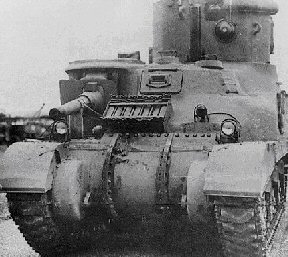
The C.D.L., courtesy, David Fletcher, Bovington Tank Museum; used with permission.
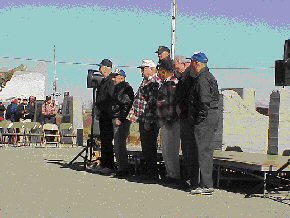
WW2 veterans who trained in Camp Bouse. Mr. Pete Henson is front row, center, with white baseball cap.
2002 photo. R. Baty
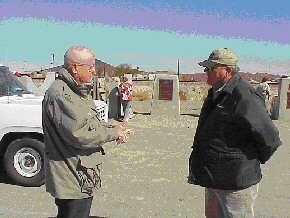
Lt. Col. John Lynch, noted author about the Desert Training Center, discusses a fine point about WW2 aircraft with my colleague, Mr. Don E. Hunt, from Redlands.
|